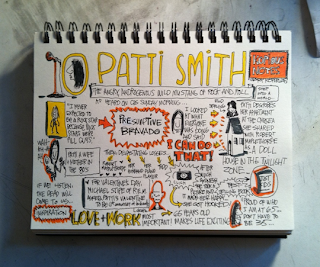Don’t dis the doodle: The cognitive impact of doodling while in the classroom
Don’t dis the doodle: The cognitive impact of doodling while in the classroom
 |
| DARE TO DRAW: This is a doodle Gary drew to visualize the life of American singer-songwriter, Patti Smith. |
Have you ever found yourself listening to a lecture in class, and suddenly realized the margins of your paper are filled with doodles of shapes, letters, and designs? Don’t worry. Even if you were scolded for doodling in elementary and middle school, there is now evidence that doodling can improve your ability to capture the information your professor is sharing during a lecture!
When we heard about this idea from Gary Kopervas, Vice President, Brand Strategy, at 20nine, a marketing and advertising design company in Philadelphia, we were eager to learn more. So we invited him to come to campus for a seminar about how doodling can open the mind. Gary, who has a background in design and has been a syndicated cartoonist for over 20 years, presented on how misunderstood doodling is. In fact, his mantra is: “Doodling is a visual tool for an active mind … not a distraction for a lazy mind.”
Gary told us that doodling is a skill that forces the listener to organize and align his thinking during a lecture. That’s because doodling performs two basic functions: It telegraphs what’s important, and helps turn information into a story, making it easier to remember.
Doodling also helps you remember information because roughly 75 percent of the human brain is wired for visual stimulus. In fact, according to researchers, you only retain 10 percent of what you’ve heard 72 hours later, but you retain 90 percent of what you’ve seen one year later. So visualizing information spoken during a lecture through doodling can improve your retention and help you capture the important takeaways.
In a culture pressed for time, space, and attention, doodling is a serious tool that can be used for visual note-taking and idea generation. The good news is that there is no right or wrong way to doodle, but almost all are made up for the six fundamentals:
- Letters
- Bullets
- Frames
- Connectors
- Shadows
- People
So don’t be afraid to doodle! Go ahead and fill those margins because it can help you think, learn, and create. After all, you can’t solve what you can’t see. Thanks, Gary, for sharing with us.
Do you doodle while listening to lectures? Do you find it helps you retain information?
- Prev Post
- Next Post
© 2024 Peirce College. All rights reserved.

LeaveComment